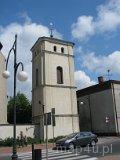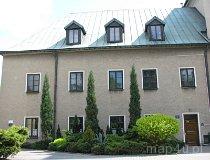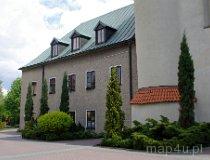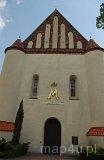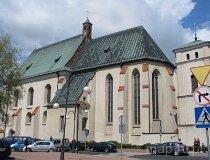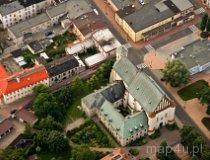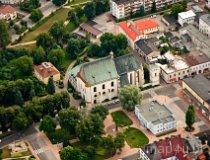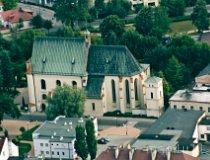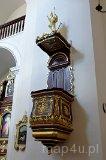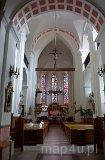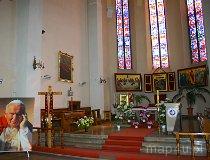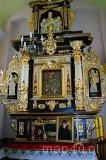Augustinian monastery complex
Description
The impressive Gothic and Baroque structure of the church consists of a rectangular nave, a more narrow long polygonally closed presbytery and a chapel adjoined to the south side. The temple is oriented. From the west, the façade is enclosed with two towers and crowned with a reconstructed blind triangular pediment gable. The church is covered with saddleback roofs. The south entrance of is through a Gothic portal with a mullioned frame from the 14th century. Inside, in the west side of the nave, there is a narthex and above, there is a choir connected with galleries running along the axis of the nave, which, along with pilasters, come from the Baroque reconstruction period in the 17th century, when the temple was converted into a pilaster church. The nave is separated from the presbytery by a Gothic pointed-arch rood screen. The presbytery has barrel vaulting with lunettes and from the south side of the church, there is adjoined a chapel with groined vaulting. In the presbytery, there are preserved original large Gothic pointed-arch windows situated between massive buttresses. The windows of the presbytery are made of stained glass depicting scenes from the friars’ life and legends about the founding of the town and the monastery. Inside the church, there are many historic works of art of great value. The furnishing of the temple is really impressive. The most part of it come from the collegiate church destroyed by the German army.
Date or time of building
1217 r. (XIII w.)
Building material
Limestone and sandstone.
History
Augustinian church, currently the Corpus Christi church (St Mary of the Visitation church) is a collegiate church and the oldest survived church in Wieluń. It was founded in the middle of the 13th century by the order of Władysław Odonic. The beginning of the currently existing building are dated back to the 14th century Casimir the Great’s foundation. In 1335, on the place of the previous church which burned, there was founded a new one, made of stone. Unfortunately, in the 15th century, the building was plundered by the duke of Oświęcim and in the “Swedish Deluge” (Swedish invasion of Poland in 1655-60) period, it was almost completely destroyed. Moreover, the church burned several times. The most tragic in consequences was the fire in 1858, especially because the times of the partitioned Poland were not conducive to reconstruction works.
In 1846, by the tsar’s ukase, all monasteries in the Kingdom of Poland were dissolved as a repressive measure after an uprising. For the Augustinians, a single monastery without novitiate was left. It was the Wieluń monastery, where the other friars from dissolved monasteries were placed. In that time, there were 26 friars in the convent: 22 fathers, 3 clergymen and 1 layman. Dionizy Lebiedziński became the prior.
In 1893, the church was taken away from the Augustinians and given to the diocese. The library consisting of 993 volumes and the archives were taken over by the partitioners’ authorities; some of them enriched the collections of the libraries in Warsaw. In 1921 the church and the monastery were taken over by the Missionaries of the Holy Family who ran a theological college there. Plastering the building was their initiative. During the second world war, the temple was defiled by the German invaders and intended for the prison camp for the persecuted Jews. Supposedly, 10,000 people, who then were sent to the Łódź ghetto and the extermination camp in Chełmno nad Nerem, were held there.
In 1965, the Pope Paul VI’s edict raised the church to the rank of the St Mary of the Visitation collegiate church and, in 1971, the painting of the Saint Mary of Consolation was crowned by the cardinals Stefan Wyszyński and Karol Wojtyła.
In the church and the former monastery building, there are several commemorative plates. In 1962-1964, the church was renovated. The ceramic roof was reconstructed, its ridge was raised, the bricked-up windows were reopened, the stained glass windows reinstalled and the paintings renovated, which restored the original Gothic character of the building.
Curious details
In the corridor of the preserved north wing of the monastery, there is a “kuna” or a pillory (a medieval device for holding criminals, consisting of three stone blocks). It is accessible for the visitors (this part of the monastery is open). In addition, in the corridor there are several commemorative plates of priests connected with the Corpus Christi church.
In the south elevation, a modern metal door with a series of bas-reliefs depicting the most important events from the history of Wieluń was fixed into a Gothic portal.
Object location
The complex is situated in the centre of Wieluń, in Augustiańska Street leading to the north. It is the highest building in the centre of the town, perfectly visible even from greater distance.
The surrounding areas belonging to the parish were formerly monastery gardens. There was also a cemetery there. Moreover, there is a statue of St John of Nepomuk, formerly standing in Różańska Street. The rectory is adjoined to the church from the north. Nearby, on the corner of Augustiańska and Okólna Streets, there is a brick Baroque bell-tower from the 18th century.
Around 200 m to the south-east of the complex (on the market), there is a bus stop.
Around 800 m to the north-east of the complex, there is a bus station in Wieluń, from where buses depart to many local destinations, as well as to some cities in Poland, including Łódź, Wrocław, Cracow, Katowice and Opole.
Around 1200 m to the north-east of the complex, there is a railway station in Wieluń, from where trains depart to Katowice (2 trains daily), Szczecin (2), Pątnów (2), Tarnowskie Góry (1), Kępno (1), Częstochowa (1) and Cracow (1).
Accessibility
The church is open every day.
Sources, links
1. Ciekliński, Z. Zabytki Ziemi Wieluńskiej. Łódź, 1963.
2. Hohensee-Ciszewska, H. and B. Wolff. „Powiat Wieluński.” Katalog Zabytków Sztuki w Polsce: Województwo Łódzkie 12.2. Ed. J. Łoziński.
3. Olejnik, T. Leksykon Miasta Wielunia. Wieluń, 2007.
4. Olejnik, T. Wieluń. Dzieje Miasta. Piotrków Trybunalski, 2003.
5. Olejnik T. Wieluń i Okolice. Łódź, 1980.
6. http://www.adiec.czest.niedziela.pl/parafie/p_wielun_nawiedzenia_najsw_maryi_panny.php
7. http://www.it-jura.pl/pl/klasztor.php?go=wielun2
8. http://miastowielun.ovh.org/zabytki.php?str=Kosciol%20Bozego%20Ciala
9. http://old.ziemialodzka.pl/31_wielun_augustianie.htm
10. http://www.um.wielun.pl/index.php?page=kosciol-bozego-ciala
Owner, manager
The Roman Catholic parish in Wieluń





